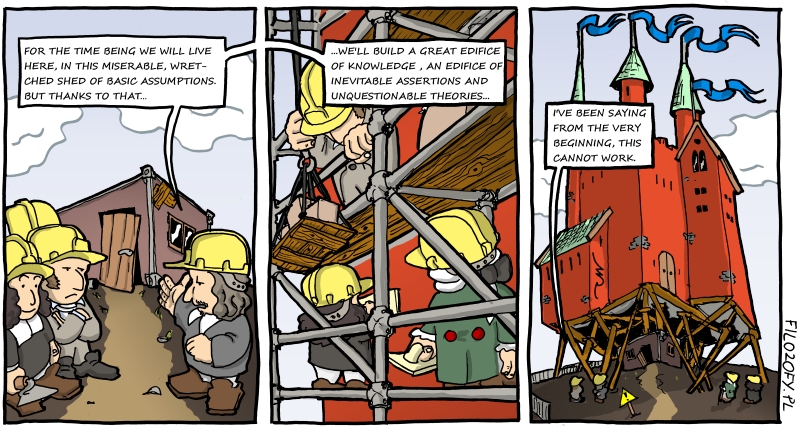1.V: Being-in as such (pp.
169-224, §§ 28-38)
Wednesday, 25 November 2015
(Notes by Marton Ribary)
Structure of Heidegger’s
discussion of “Being-in”
Heidegger discusses the “Being-in”
of Dasein in two major sections. One considers the existential constitution of the
“Da-“ of Dasein, the other the everydayness of Dasein. “Da-“ is explicated
according to disposition (Befindlichkeit, translated by Macquarrie-Robinson
with the unfortunate expression “state-of-mind”) and understanding (Verstehen),
and the relation of these two constitutive characteristics in interpretation,
assertion and discourse (Rede, possibly equivalent with parole). Heidegger discusses
the everydayness of Dasein via idle talk (Gerede, which bridges the two
sections), curiosity (Neugier) and ambiguity (Zweideutigkeit). These three aspects
are reminiscent of sophism as ridiculed by Socrates in the dialogues of Plato. Heidegger’s
description of everydayness may have Platonic origins. The three aspects of Gerede,
Neugier and Zweideutigkeit are brought together in one complex phenomenon which
Heidegger describes as Dasein’s fallen character (Verfallen), a tendency which
cannot be avoided. Heidegger insists that neither Verfallen, nor its
constitutive aspects are meant to be negative or in any way derogatory about
Dasein – it is just a fact, nothing more.
Disposition (Befindlichkeit)
Disposition is the way how I find
myself in the world. My mood (Stimmung) is a surface manifestation among other
possible manifestations of that disposition. Disposition expresses Dasein’s openness
to the world and makes Dasein capable to see the world being disclosed. To put
it in simple terms, disposition resembles some kind of unarticulated knowledge.
Before the knowledge about the world is articulated, it has been always already
known through Dasein’s disposition.
Fear (Furcht)
Heidegger demonstrates his
understanding of disposition on the example of a negative manifestation, namely
fear (Furcht). His selection of a negative examples in SZ is conspicuous,
and it may be motivated by the via negativa approach of Medieval
scholasticism which insisted that God’s true nature is beyond human understanding
and can be approximated only negatively by saying what God is not. For Heidegger,
Dasein seems to be a similarly puzzling phenomenon which resists to be described
in positive terms. Heidegger uses the example of fear in other parts of SZ
when he discusses anxiety (Angst, fear without an object) and Being-towards-death
(Sein-zum-Tode, anxiety about one’s finiteness) later on. Heidegger investigates
the phenomenon of fear systematically in three parts. If the phenomenon of fear
is symbolically described as A↔B, then the three parts are “the very entity
which is afraid” (A), “that in the face of which we fear” (B), and “fearing as
such” (↔) (140-141).
In/authenticity
Inauthenticity is equated with
the complex phenomenon which is Dasein’s factical fallen character (Verfallen)
as Heiddeger passingly writes: “falling, what we have called the ‘inauthenticity’
of Dasein” (175). The authenticity/inauthenticity divide is about Dasein’s
potential character to be its Self or not be its Self. The latter option, that
is, Being not its Self is the same as falling into the world. This is not an
ethical choice for Dasein as Heidegger notes that Dasein is “already always”
fallen. That Dasein has a fallen character is a fact, it is a starting point,
not the result of an ethical choice. “Dasein has always already (zunächst immer
schon) fallen away from itself as an authentic potentiality for Being its Self,
and has fallen into the ‘world’”. (175) The everydayness of Daesin’s fallen character
separates Dasein from its potential to be its Self. Everydayness pushes Dasein into
the “they” where Dasein follows a set path and exercises a routine. Dasein then
exists not as its Self, but as one of the “they”. (The idea of “they” is also
reminiscent of the Socratic critique of sophism which is described to be the
wisdom pleasing the “masses”, the polloi.)








